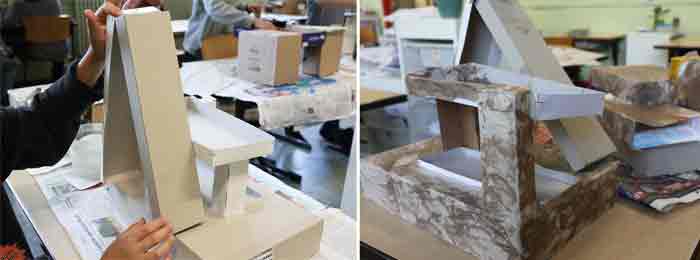Zhang Ming, Qilu Normal University, Jinan, Shandong, China & Katharina Linsel, Augsburg University, Germany
Children from Jinan, China aged 7 – 9 and 3rd and 4th graders from Augsburg, Germany aged 8 – 10 have been creating images and pictures adopting techniques and works of art from both of their cultures. Zhang Ming and Katharina Linsel have chosen suitable objects together. What is considered suitable has been discussed beforehand and is dependent on icons of each culture and concepts that are planned individually in each setting. These concepts include but are not limited to thoughts on materials and techniques that constitute images and pictures, as well as courses of action, also depending on time and place as the Augsburg project takes place in primary school classrooms in between general lessons.
We pose the question how, and which images and pictures emerge when children of different origin are faced with art of different origin. Also, what do we want the children to learn choosing certain artists' work, techniques and subjects? How do we pick up their preconcepts and existing knowledge? How do we teach them – in regard to a didactic overall concept? In which contexts do we work with the children – concerning institutions, syllabuses, projects?

Fig. 1-3
In a teaching unit on portraits we stayed in the western world following Zhang Ming’s suggestion of Chagall’s ‘I and the Village’ (1911). While some Chinese students have largely copied Chagall’s depiction of his home in a small village of Vitebsk, inspired in part by the recent development of Cubism in Paris, German students started with portraying each other applying monotype (fig. 1 – 3). Surrounding those monotypes is their distinct vocabulary of imagery depicting their own perception of home (fig. 4 + 5).

Fig. 4-7
J. Howard Miller suggested ‘We Can Do It!’ (1943), originally created by the graphic artist to boost morale of the largely female workforce in the war industries during World War II, and that has become an advertising icon in the western world since the 1980s. A fourth grader from Augsburg told the class during their discussion that he had recently seen it at his mother’s hairdresser. Some of his classmates were reminded of the current war in Ukraine (fig. 6 + 7). Students from Jinan adapted the poster style and created pictures of physical or female strength (fig. 9 + 10).

Fig. 8-11
Another unit focused on landscapes from the perspective of traditional Chinese painting and its successors. After having watched a dance show about Wang Ximengs A Thousand Li of Rivers an Mountains (1113), also called Green Landscape, children from Jinan proceeded to draw landscapes in yellow, green and blue oil pastels, sometimes copying fragments of the original painting (8 + 11). Children in Augsburg have also observed basic modeling elements such as lines, shapes, colors, light and shade in printed landscapes they have sketched on with chalk pastels (fig. 12 – 16).

Fig. 12-16
They also tried to apply formal principles such as symmetry, repetition, rhythm and contrast getting inspiration by ink paintings of Li Keran (1907 – 1989) and Guanzhong Wu (1919 – 2010). The German partner has chosen this very famous painter in China due to their horizontal or vertical compositions, their use of foreground, middle- and background, as well as drawing with fine lines and painting with bold brushes at the same time. Li Keran is supposed to have introduced light and shade to traditional Chinese ink painting.

Fig. 17-18
The unit on architecture is still in progress. First examples in Augsburg (fig. 17 + 18) show models featuring inspiration from interleaving structures of Frank Lloyd Wright’s Fallingwater (1936) and upcycling materials like the Chinese architect Wang Shu did with used bricks in Ningbo Historic Museum (2008).
